St. Brigid epitomizes everything a strong Irish woman should be, and she holds a special place in many Irish hearts, including mine.
When we think of Irish saints, good old St. Patrick first springs to mind, but let’s face it, he was a blow-in from England, France, or Wales … nobody knows for sure.
St. Brigid is actually the first native-born Irish saint, and a true role model for independent, feisty Irish women.
In the past we have explored St. Brigid’s legacy, learning why St. Brigid’s Day and the beginning of spring or Imbolc, the old Celtic spring festival are linked.
This year I’ve decided to share my thoughts on who Brigid was as a woman, as a role model, and try to figure out why she is so beloved by many Irish people around the world.
The generous spirit of St. Brigid
Brigid’s childhood was a privileged one, but she was not a spoiled, self-centered little girl. Her's was no rags to riches story, but the tale of a girl determined to share all she had with the poor.
Her abundant generosity is recorded in many Irish legends where she is described as one of the most open-hearted, giving souls to ever live in the Emerald Isle.
Much to her father’s chagrin, she gave away his milk, his butter, and his meat to all and sundry who passed their door in need of a bite to eat.
Her father decided the best solution to control his overly charitable daughter was to marry her off and pass the problem on to her husband.
But Brigid had no intention of marrying, even if her chosen was the King of Leinster himself.
Brigid waited in their chariot while her father negotiated her marriage deal with her royal suitor. Her father left his bejeweled sword with Brigid since etiquette demanded he bear no weapons to an audience with the King.
As Brigid waited a leper approached. She had nothing to share with him, only her father’s sword, so she gave it away so the leper could sell it.
Well, as you can imagine, her father was none too pleased when he returned to introduce her future husband, who immediately began to reconsider his decision to marry this leper-loving girl.
“Will you give away my riches too?” he asked her, to which she replied, “I would give all the wealth of Ireland away to serve the King of Heaven.”
The King of Leinster knew Brigid was no shrinking violet and far more than he could ever handle or contain. He immediately granted her wish to become a nun.
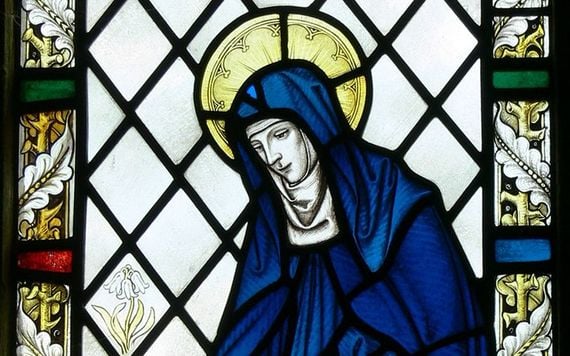
A stained glass window featuring Saint Brigid.
A tough Irish woman
And so, from an early age, Brigid showed she was strong-willed, and smart attributes helped her grow into a great leader.
Another legend claims she avoided marriage to the King by praying to God to take away her beauty. She soon developed the pox, disfiguring one half of her face, thus making her unmarriageable.
The King of Leinster himself granted her land in Kildare to build her monastery. Legend has it he granted her an amount of land equal to the size of her cape.
Once Brigid spread her cape over the ground, it kept spreading and spreading until it covered a vast acreage. The King could not renege on his promise and gave her all the land covered by her cape, upon which she built a great monastery, for both monks and nuns.
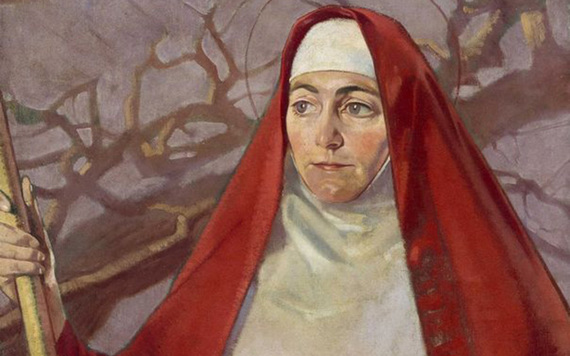
A beautiful painting by Patrick Joseph Tuohy of St. Brigid.
St. Brigid's center of great learning
St. Brigid promoted learning and craftsmanship within her community of holy men and women.
When Gerald of Wales visited Kildare in the 12th century, he described the Gospel Book of Kildare as being so beautiful it must have been the work of angels.
This magnificent work of art has been lost over the centuries, but some believe it may be the famous Book of Kells or a similarly illuminated manuscript.
A woman who knew how to party
Not only was Brigid a master of 5th-century multi-tasking, but she was also kind and compassionate, and very fond of a good party.
She understood the importance of good food with plenty to drink when family, friends, and strangers gathered together.
Brigid liked an odd beer, or two or three or four. She brewed beer. She served beer in abundance. She drank beer. She gave her beer away. And when she didn’t have enough beer to go around, she miraculously created more beer from water.
One keg of Brigid’s beer not only satisfied a monastery of monks in need of ale, it quenched the thirst of 17 more monasteries full of beer-loving saints and sinners. She turned well water into ale on one occasion, and the old legends of her brewing prowess record other beer-making miracles.
One can’t but help notice the similarities between Brigid’s miracles and Jesus’ miracles in the Bible. Stories of turning water into wine may not have been understood by 5th-century Celts, but a woman changing water into beer may have made these miracles far more realistic for our pagan ancestors.
Fact or fiction we’ll never know, because in Ireland we always say, “never let the truth get in the way of a good story” and there are plenty of good stories when it comes to St. Brigid.

Love Irish history? Share your favorite stories with other history buffs in the IrishCentral History Facebook group.
Saint Brigid’s Holy Wells
Holy wells dot the Irish countryside, and many are named after St. Brigid. Our superwoman saint of the 5th century probably never set foot next, nigh nor near most of these wells, but her name was bestowed upon them through her namesake Brigid, the Celtic goddess of fire, poetry, unity, childbirth, and healing.
Holy wells were sacred places for the ancient Celts. When Irish people converted to Christianity, they transferred many rituals from their Celtic Religion directly into their new Christian traditions. The fact their very first female saint was named after the old Celtic goddess made this transformation of sacred places all the easier.
And so, St. Brigid’s holy wells are still visited to this very day. A small “clootie” or a piece of cloth is dipped into the well.
The water is used to wash any wounds or bless any ailing part of the body. The clootie is then tied to a tree to seek spiritual healing. Old rags can be seen tied to trees around these holy wells to this very day.
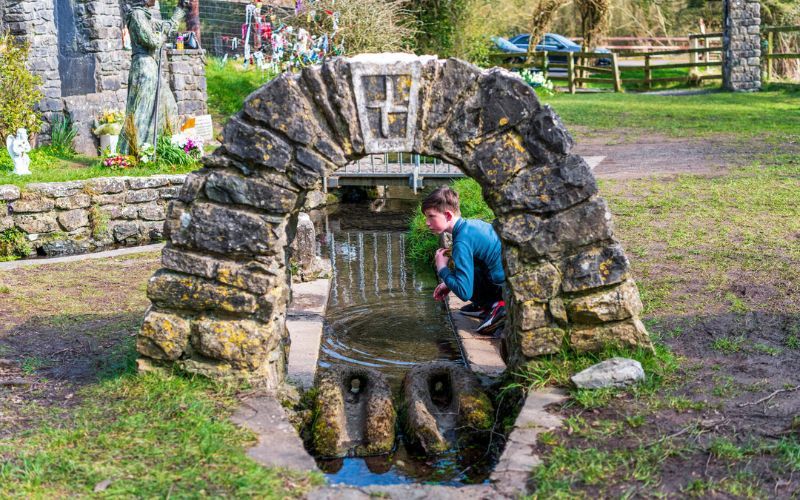
Brigids Holy Well in Co Kildare. (Ireland's Content Pool / Gareth Wray)
A symbol of fire
St. Brigid is symbolized by fire in old Irish tradition. What better way to memorialize a stubborn, fiery woman? In her honor, a perpetual fire was kept burning in her monastery in Kildare for over one thousand years.
Fire represents her wisdom, love of poetry, her healing ministry and her support for the art of metallurgy.
Her flame burned brightly in Kildare for centuries. It was extinguished in 1220 by Henri de Londres, a Norman Archbishop of Dublin or other stories claim it burned until 1540 when it was extinguished by none other than Henry VIII when he ransacked Ireland’s religious houses and brought about the Dissolution of the Monasteries.
A perpetual flame burns once again in her honor in Kildare. On February 1st, 1993 a flame was relit in the Market Square in the town and is now kept burning at Solas Bhride, a Celtic Spirituality Center. Hats off to the people of Kildare for reigniting devotion to this Irish woman of the ages.
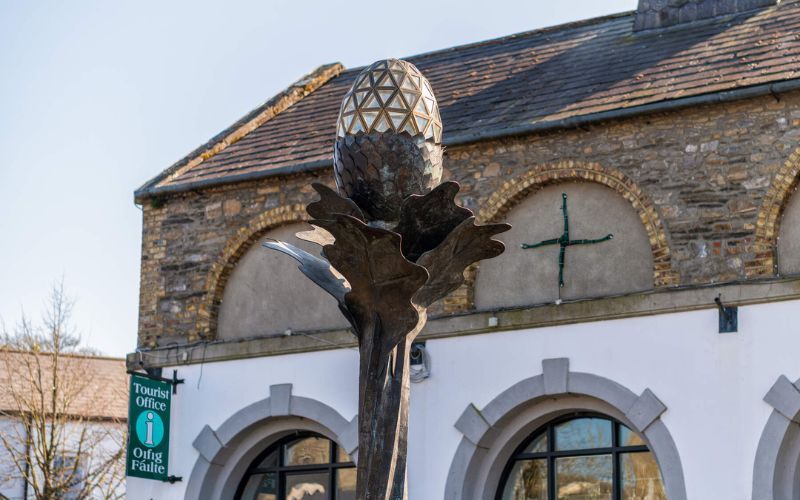
The Sacred Flame in Kildare Town. (Ireland's Content Pool / Gareth Wray)
The prayer of St. Brigid
A poem dating to the 8th century is attributed to St. Brigid and is preserved in a manuscript in a Brussels’ library. Her poetic words sum up her outlook on life, and above all her great faith:
“I should like a great lake of the finest ale
for the King of kings.
I should like a table of the choicest food
for the family of heaven.
Let the ale be made from the fruits of faith,
And the food be forgiving love.
I should welcome the poor to my feast,
for they are God’s children.
I should welcome the sick to my feast,
for they are God’s joy.
Let the poor sit with Jesus at the highest place,
and the sick dance with the angels. . .
- quoted in Van de Weyer, "Celtic Fire"
St. Brigid’s Day blessings to all
And so, St. Brigid definitely deserves the title of a strong Irish woman. She was direct, confident, and outgoing. She knew what she wanted, and she made sure she accomplished her goals. Never self-centered she cared for the sick, the poor, and the dying.
This St. Brigid’s Day, let’s pray that in the coming year, we may live lives filled with concern for others, demonstrated by generosity towards those in need, just like St. Brigid.
But may we also emulate the self-confident, brave, and fiery spirit of the bold Brigid whenever life so demands.
Lá Fhéile Bríde Shona Daoibh, Happy St. Brigid’s Day - Irish American Mom.
*Mairead Geary came to America for one year 20 years ago. She now lives with her husband and children in Kentucky and is proud to be an American citizen. Read more on her blog here.
*Updated in Jan 2025.
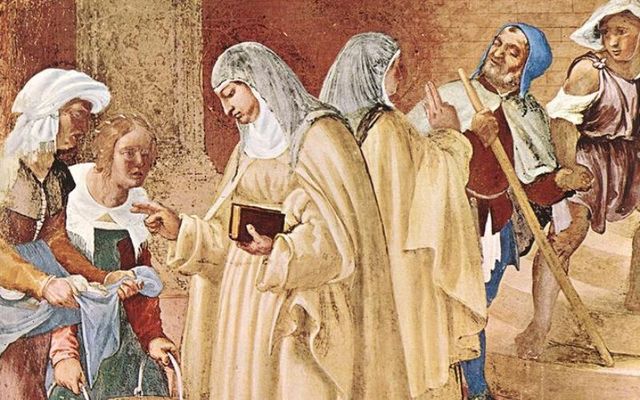



Comments